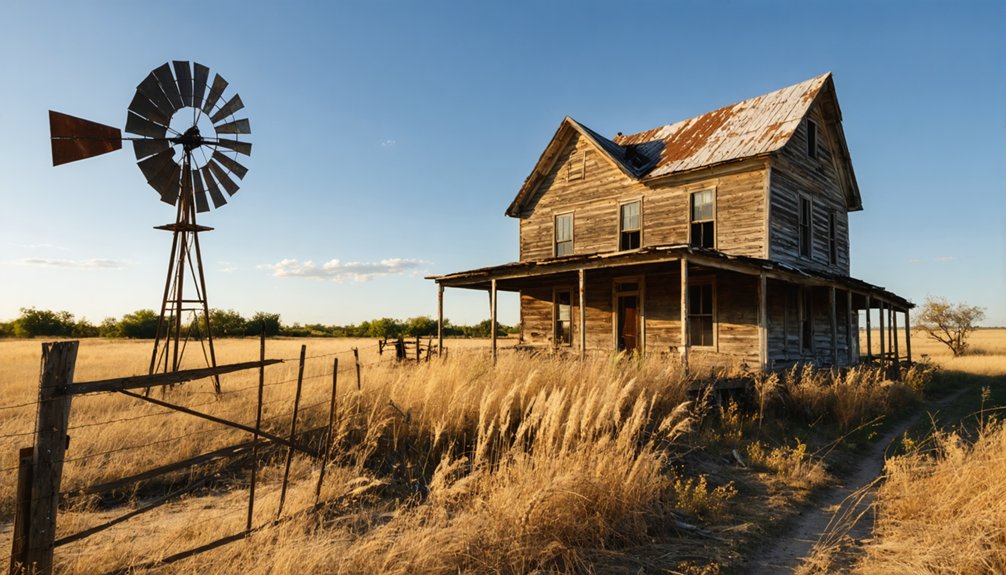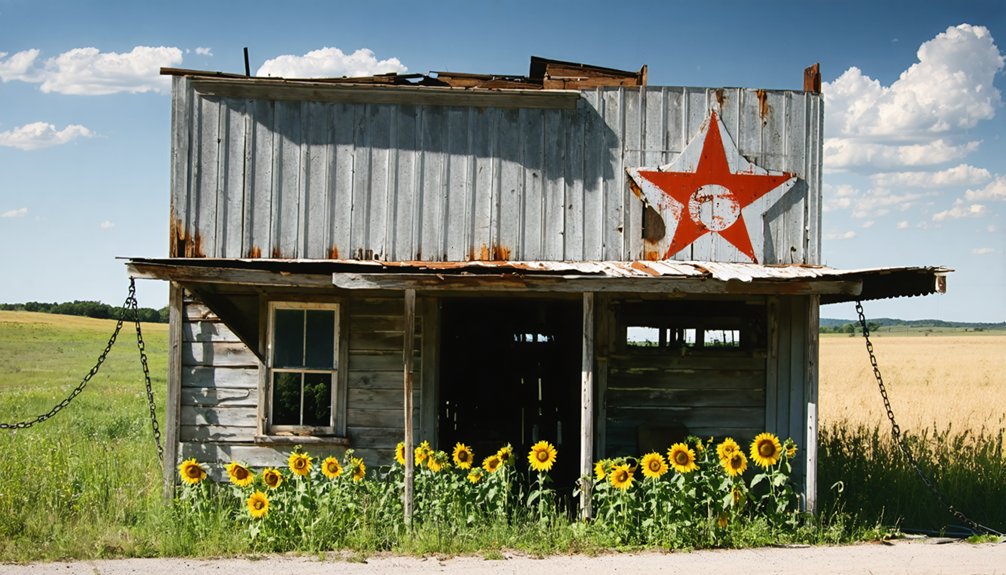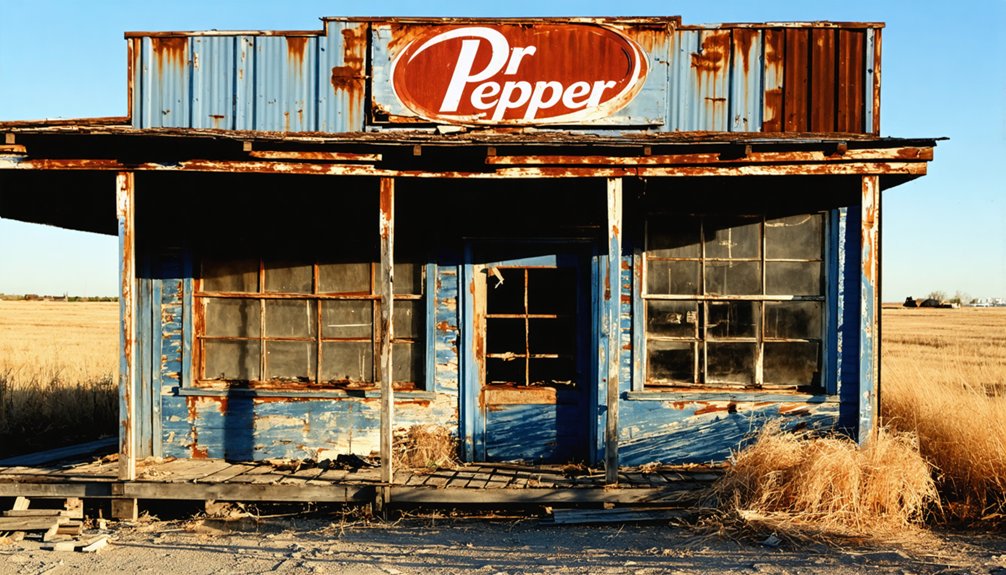You’ll find Ebony’s remains in Hutchinson County, Texas, where this ghost town first emerged in 1890 as “Buffalo” before changing its name in 1891. The community thrived on cotton production, supported by essential institutions like a church, school, and post office. Economic challenges, including the devastating boll weevil infestation and agricultural mechanization, led to its decline by mid-20th century. Today, only two structures survive: a main building and the Buffalo-Ebony Cemetery, each holding untold frontier stories.
Key Takeaways
- Ebony, Texas was established in 1890 as Buffalo and renamed in 1891, becoming a thriving agricultural community centered around cotton production.
- The town’s decline began with the boll weevil infestation in the early 1900s, leading to economic devastation and population loss.
- Only two original structures remain today: a main building from the 1950s and the Buffalo-Ebony Cemetery.
- The community’s downfall was accelerated by agricultural mechanization, soil depletion, and young residents moving to urban areas.
- Ebony now serves as a historical example of frontier settlement, with its legacy preserved through ghost town tours and historical records.
The Birth of a Rural Community
While many Texas ghost towns faded into obscurity, Ebony’s story began in 1890 as a settlement originally named Buffalo. When the town’s post office application was rejected in 1891, you’d have seen the community adapt by changing its name to Ebony – a prime example of rural adaptation to administrative requirements. Similar to how Plemons Crossing became a vital hub, these early Texas settlements were critical waypoints for travelers.
The founding families, mostly European-American settlers from the South, established themselves on the rolling prairies of Mills County. Through determined community organization, they built the essential pillars of rural life: a church, school, and post office.
These institutions served as the backbone of social life, while the fertile land provided opportunities for both subsistence and commercial farming. The geography shaped not just their livelihoods but also their social structures, centered around shared agricultural labor and communal gatherings. Like many rural Texas towns, their economy was devastated when the boll weevil infestation destroyed massive cotton yields in the early 1900s.
Economic Rise and Agricultural Roots
You’ll find Ebony’s economic foundations were firmly rooted in cotton production, which attracted settlers and spurred the development of essential processing facilities like cotton gins and related businesses.
Like the town of Carlton in 1910, Ebony’s agricultural success led to significant population growth and economic prosperity during its peak years.
The town’s agricultural portfolio expanded beyond cotton to include livestock and diverse farming operations, creating a more resilient local economy.
As the farming community flourished, Ebony transformed into a small business hub, with merchants and service providers establishing shops to meet the growing population’s needs.
Similar to families displaced by Toledo Bend Reservoir, many farming communities across Texas faced relocation due to large-scale infrastructure projects.
Early Cotton Trade Growth
As Spanish missionaries first introduced cotton cultivation to Texas in the early 18th century, they laid the groundwork for what would become one of the state’s most transformative agricultural enterprises.
By 1835, you’d find cotton exports reaching an impressive 3.15 million pounds annually, dramatically shifting Texas’s economic influence. Trade routes evolved from early Mexican markets to more lucrative U.S. connections, particularly as Anglo-American settlers established plantations between the Brazos and Colorado rivers. The crop-lien system after the Civil War created a cycle of debt peonage that trapped many farmers. This economic boom transformed Texas from 1/1000th to 1/16th of Mexico’s total economy within just a decade.
- Initial shipments relied heavily on river transport to reach southern markets
- Early cotton exchanges helped organize sales and stabilize pricing
- Expanding railroad networks opened access to national markets
- San Felipe de Austin’s plantations served as essential economic hubs in the 1820s
The rapid growth transformed Texas from a minor player to a significant force in the cotton trade, with production skyrocketing to 431,645 bales by 1859.
Livestock and Farm Diversity
The agricultural landscape of Ebony reflected the broader patterns of farm diversification common across Central Texas in the late 1800s.
You’d find a mix of Texas Longhorns, Black Brangus, and Charolais cattle breeds grazing alongside horses and pigs on family-owned ranches. These operations often stretched back to post-Civil War settlements, forming the backbone of local commerce. Like the thriving town of Dearfield Colorado, the community established its economic foundation through successful farming ventures.
Smart farmers didn’t put all their eggs in one basket. While cotton remained king, they’d supplement with corn, sugarcane, and purple hull peas. Today, this area’s farming legacy continues with Black agricultural producers representing nearly a quarter of all Black farmers nationwide.
This crop rotation helped maintain soil health and provided economic stability when cotton prices fluctuated or pests struck. When the dreaded boll weevil arrived and cotton yields declined, many farmers adapted by converting their depleted fields to pastureland, ensuring their operations’ survival through changing times.
Small Business Hub Development
Building on its strong agricultural foundation, Ebony’s business district emerged as a modest but crucial hub serving local farmers and ranchers in the late 19th century.
Local entrepreneurship focused on meeting the community’s basic needs, with businesses strategically aligned to support the agricultural economy. Similar to how rural hospital closures have devastated modern Texas communities, the loss of critical services impacted small towns like Ebony. Like Thurber’s infamous company store system, local merchants often extended credit to farmers between harvests. You’ll find that business sustainability depended heavily on the seasonal rhythms of farming and the prosperity of local crop production.
- General stores supplied essential goods and farming equipment
- Blacksmith shops provided critical equipment repairs and metalwork
- Cotton gins processed the area’s primary cash crop
- Mule-powered mills helped process grains for local consumption
Without railroad access, Ebony’s businesses remained small-scale operations, but they formed the backbone of the community’s economic life until larger regional centers and changing transportation routes began drawing commerce away.
Life in Early Ebony
Life in early Ebony centered around a close-knit farming community, where settlers from Georgia, Mississippi, and other southern states carved out homesteads in the Texas frontier.
You’d find families working their cotton fields during the day, while maintaining settler traditions through regular community gatherings at the local church and general store.
Your daily routines would’ve revolved around agricultural pursuits, with neighbors helping neighbors during harvest seasons.
The wooden homes, often simple log cabins, dotted the carefully planned townscape.
You’d send your children to the local schoolhouse, which might’ve doubled as a church on Sundays.
The post office served as your lifeline to the outside world, while unpaved roads connected you to nearby markets, though travel could be challenging during poor weather.
The Path to Abandonment

While early settlers built Ebony through determination and community spirit, economic hardships began chipping away at their frontier dream by the mid-20th century.
Despite their cultural heritage of resilience, you’ll find that post-World War II changes proved insurmountable for this once-thriving community.
- The closure of the post office and general store stripped away essential gathering places
- Agricultural mechanization and soil depletion forced family farms into decline
- Limited road access and lack of railroad connections isolated the town from progress
- Young residents sought opportunities in urban areas, leading to population decline
The community’s spirit couldn’t overcome these mounting pressures.
Without economic alternatives or modern infrastructure, Ebony’s families gradually dispersed to nearby towns with better prospects, leaving their pioneer dreams behind in the Texas dust.
Legacy and Historical Impact
Though Ebony now stands silent, its legacy echoes through Texas history as a poignant example of early 20th-century frontier settlement and community resilience.
You’ll find its cultural significance woven into the fabric of regional heritage tourism and historical studies, where it serves as a window into the challenges faced by early Texas settlers.
The town’s community dynamics, shaped by its post office, churches, and local institutions, reflect the determined spirit of frontier life.
While Ebony’s physical structures may have vanished, its story lives on through preserved records, maps, and family histories.
Today, you can explore its impact through ghost town tours and historical society collections that document the rise and fall of rural Texas communities.
What Remains Today

If you visit Ebony today, you’ll find few remaining physical structures beyond scattered ruins and deteriorating foundations, as most original buildings have succumbed to time and neglect.
Access to the site is restricted due to private property ownership, requiring permission from current landowners before exploring the area.
While on-site historical markers are scarce, documentation about Ebony’s past can be found in regional archives and historical societies, preserving the ghost town’s story for future generations.
Physical Structures and Ruins
Remnants of Ebony’s once-thriving community have largely vanished from the Texas landscape, with only two significant physical structures surviving into modern times.
You’ll find a solitary main building still standing prominently since the 1950s, along with the well-maintained Buffalo-Ebony Cemetery serving as a cultural landmark. These physical remnants offer rare glimpses into the town’s architectural significance and historical legacy.
- The lone building stands isolated, a silent sentinel to Ebony’s past
- Buffalo-Ebony Cemetery remains as a preserved cultural touchstone
- No visible foundations or structural ruins mark the original town layout
- Natural vegetation has reclaimed most of the former townsite
The surrounding rural landscape has reverted to its natural state, with minimal infrastructure remaining to mark this once-bustling settlement.
You won’t find any other buildings, signage, or notable artifacts from Ebony’s heyday.
Private Property Access Issues
Today’s visitors hoping to explore Ebony’s historic sites face significant access challenges, as the majority of the former townsite sits on private property.
You’ll encounter fences, locked gates, and clear “No Trespassing” signs that legally restrict entry to the area. Private ownership of the land means you can’t explore without explicit permission from the current landowners.
Unlike publicly accessible ghost towns such as Terlingua, where you’re free to roam and photograph ruins, Ebony’s remaining structures and artifacts are largely off-limits.
The access restrictions make it difficult to view any surviving foundations or historic features, as they’re often obscured by vegetation or hidden behind barriers.
If you’re interested in exploring Ebony’s history, you’ll need to rely primarily on documented records and photographs rather than direct site visits.
Historical Documentation Available
While historical documentation about Ebony remains sparse, researchers can piece together the town’s story through a combination of county records, land deeds, and scattered mentions in Hutchinson County archives. The archival challenges stem from typical rural record losses and the town’s decline by the late 1950s.
Historical significance can be traced through period maps showing Ebony’s location relative to railway lines and early roads.
- Most visual documentation comes from aerial surveys and satellite imagery
- County historical records provide context about the 1880s settlement period
- Old maps help establish Ebony’s role in regional transportation networks
- Land deed records offer insights into property ownership and development patterns
You’ll find few preserved landmarks or extensive courthouse records, making research heavily dependent on broader regional archives.
Frequently Asked Questions
Were There Any Notable Crimes or Murders in Ebony’s History?
Like footprints in shifting sand, you’ll find few documented notorious incidents in Ebony’s past. While violent crime plagued East Texas ghost towns, specific unsolved mysteries for Ebony remain historically unconfirmed.
What Natural Disasters, if Any, Impacted the Town of Ebony?
You won’t find documented flood impacts or tornado damage for this town. While natural disasters affected many Texas ghost towns, there’s no clear evidence of major disasters hitting Ebony specifically.
Did Any Famous People Ever Live in or Visit Ebony?
You won’t find records of famous visitors or historical figures in Ebony. Based on thorough historical documentation, there’s no evidence that any nationally recognized personalities ever lived in or visited this town.
What Was the Highest Recorded Population of Ebony During Its Peak?
You’ll find the highest recorded population reached 113 in 1930, marking a significant population growth milestone in the town’s historical significance before its eventual decline toward ghost town status.
Were There Any Indigenous Settlements in the Area Before Ebony’s Establishment?
Like shadows in time’s mist, you’ll find indigenous tribes such as the Caddo and Comanche roamed this region, but there’s no documented evidence of permanent settlements at Ebony’s specific location before its establishment.
References
- https://mix941kmxj.com/the-strange-sad-story-of-a-texas-ghost-town-youll-never-visit/
- https://mix941kmxj.com/see-how-two-texas-ghost-towns-battled-for-the-county-and-lost/
- https://www.youtube.com/watch?v=PsuLwAQ12QI
- https://www.amysatticss.com/ghost-towns/
- https://en.wikipedia.org/wiki/List_of_ghost_towns_in_Texas
- https://www.youtube.com/watch?v=TvAbnviQDlQ
- https://www.texasescapes.com/TOWNS/Texas-Ghost-Towns-2-Central-Texas.htm
- https://theforgottensouth.com/cheapside-texas-ghost-town-history/
- https://www.texasescapes.com/TexasHillCountryTowns/Ebony-Texas.htm
- https://www.ebony.com/these-real-ghost-towns-were-once-bustling-black-communities/



